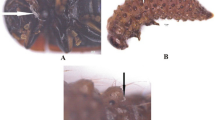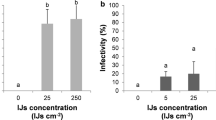Abstract
The striped flea beetle, Phyllotreta striolata (F.) (Coleoptera: Chrysomelidae) is a key pest of crucifer vegetables in Southern China. The use of entomopathogenic nematodes (EPNs) within an integrated pest management approach may offer an effective and environmentally safe strategy to suppress outbreaks of this pest. In the present study, the efficacy of Steinernema carpocapsae All and Heterorhabditis indica LN2 for the control of P. striolata in the field was evaluated, as well as the combined application of EPNs and azadirachtin against the pest. Both nematode species were capable of reducing populations of the soil-dwelling stages of P. striolata, thus leading to a reduction of the adult populations and the associated shot-hole damage on the leaves. Nematode treatments also increased cabbage yields as compared to the control and azadirachtin treatments alone. Azadirachtin alone was not effective to prevent damage by P. striolata, but it could enhance the control effect of S. carpocapsae shortly after application. Osmotically treated infective juveniles (IJs) of S. carpocapsae All performed as well as untreated IJs.




Similar content being viewed by others
References
Ansari MA, Adhikari BN, Ali F, Moens M (2008) Susceptibility of Hoplia philanthus (Coleoptera: Scarabaeidae) larvae and pupae to entomopathogenic nematodes (Rhabditida: Steinernematidae, Heterorhabditidae). Biol Control 47:315–321
Bedding RA (1981) Low cost in vitro mass production of Neoaplectana and Heterorhabditis species (Nematoda) for field control of insect pests. Nematologica 27:109–114
Burgess L (1977) Flea beetle (Coleoptera: Chysomelidae) attacking rape crops in the Canadian Prairie provinces. Can Entomol 109:21–32
Cappaert DL, Koppenhöfer AM (2003) Steinernema scarabaei, an entomopathogenic nematode for control of the European chafer. Biol Control 28:379–386
Dillon AB, Ward D, Downes MJ, Griffin CT (2006) Suppression of the large pine weevil Hylobius abietis (L.) (Coleoptera: Curculionidae) in pine stumps by entomopathogenic nematodes with different foraging strategies. Biol Control 38:217–226
Dillon AB, Rolston AN, Meade CV, Downes MJ, Griffin CT (2008) Establishment persistence and introgression of entomopathogenic nematodes in a forest ecosystem. Ecol Appl 18:735–747
Duncan LW, McCoy CW (1996) Vertical distribution in soil, persistence, and efficacy against citrus root weevil (Coleoptera: Curculionidae) of two species of entomogenous nematodes (Rhabditida: Steinernematidae, Heterorhabditidae). Environ Entomol 25:174–178
Feng HT, Huang YJ, Hsu JC (2000) Insecticide susceptibility of cabbage flea beetle (Phyllotreta striolata (Fab.)) in Taiwan. Plant Prot B Taipei 42:123–146
Gao ZZ, Wu WJ, Cui ZX (2000) Studies on the host range of Phyllotreta striolata (F.). Ecol Sci 2:70–72
Grewal PS, Ehlers RU, Shapiro-Ilan DI (2005) Nematodes as biocontrol agents. CABI, New York, USA
Guo C, Qin L, Chen H, Liu Y, Zeng T (2006) Studies on antifeeding and contact toxic activities of crude extracts of Meliaceae against Phyllotreta striolata (Fabricius). Guangxi Sci 13(1):71–74
Han RC (1996) The effects of inoculum size on yield of Steinernema carpocapsae and Heterorhabditis bacteriophora in liquid culture. Nematologica 42:546–553
He D, Xu H (2005) Control effect of azadirachtin against striped flea beetle Phyllotreta striolata (F.). Mod Agr 10:4
Hou YM, Pang XF, Liang GW (2001) On the partial application of Steinernema carpocapsae strain A24 against striped flea beetle Phyllotreta striolata. Acta Phytophyl Sin 2:151–156
Hou Y, Li L, You M (2002) Control effect of Bioact-T35 against striped flea beetle, Phyllotreta striolata (F.), in fields. J Wuyi Sci 18:202–205
Hou Y, Pang X, Liang G, You M (2003) Evaluation of azadirachtin against striped flea beetle, Phyllotreta striolata (F.). Chinese. J Appl Ecol 14(6):959–962
Kaya HK (1990) Soil ecology. In: Gaugler R, Kaya HK (eds) Entomopathogenic Nematodes in biological control. CRC Press, Boca Raton, USA, pp 93–116
Koppenhöfer AM, Fuzy EM (2003) Steinernema scarabaei for the control of white grubs. Biol Control 28:47–59
Koppenhöfer AM, Fuzy EM (2008) Effects of chlorantraniliprole on Heterorhabditis bacteriophora (Rhabditida: Heterorhabditidae) efficacy against and reproduction in white grubs (Coleoptera: Scarabaeidae). Biol Control 45:93–102
Koppenhöfer AM, Brown IM, Gaugler R, Grewal PS, Kaya HK, Klein MG (2000) Synergism of entomopathogenic nematodes and imidacloprid against white grubs: greenhouse and field evaluation. Biol Control 19:245–252
Lacey LA, Arthurs SP, Unruh TR, Headrick H, Fritts R (2006) Entomopathogenic nematodes for control of codling moth (Lepidoptera: Tortricidae) in apple and pear orchards: effect of nematode species and seasonal temperatures, adjuvants, application equipment, and post-application irrigation. Biol Control 37:214–223
Lai R, You M (2005) Anti-feeding effect of the extracts from non-preferable plants on adults of the striped flea beetle [Phyllotreta striolata (F.)]. Plant Prot 31(4):37–40
Li J, Qiu L, Wang H, Fu J (2007) Chemicals used for controlling Phyllotreta striolata (F.). Fujian J Agr Sci 22(1):15–18
Ling N (2003) Rotenone: a review of its toxicity and use for fisheries management. Department of Conservation. Sci Convers No, Wellington, New Zealand, p 211
McCoy CW, Shapiro DI, Duncan LW, Nguyen K (2000) Entomopathogenic nematodes and other natural enemies as mortality factors for larvae of Diaprepes abbreviatus (Coleoptera: Curculionidae). Biol Control 19:182–190
Negrisoli AS Jr, Garcia MS, Negrisoli CRCB (2010) Compatibility of entomopathogenic nematodes (Nematoda: Rhabditida) with registered insecticides for Spodoptera frugiperda (Smith, 1979) (Lepidoptera: Noctuidae) under laboratory conditions. Crop Prot 29:545–549
Oestergaard J, Belau C, Strauch O, Ester A, Rozen KV, Ehlers R (2006) Biological control of Tipula paludosa (Diptera: Nematocera) using entomopathogenic nematodes (Steinernema spp.) and Bacillus thuringiensis subsp. israelensis. Biol Control 39:525–531
Qiao R, Zhang W, Chen G, Hu M (2009) Field evaluation of 5 % fipronil suspension concentrates for seed dressing against Phyllotreta striolata Fabricius. J Changjiang Veg 6:67–69
Shapiro-Ilan DI, Gouge DH, Koppenhöfer AM (2002) Factors affecting commercial success: case studies in cotton, turf and citrus. In: Gaugler R (ed) Entomopathogenic nematology. CAB International, Wallingford, UK, pp 333–356
Shapiro-Ilan DI, Cottrell TE, Mizell RF III, Horton DL, Davis J (2009) A novel approach to biological control with entomopathogenic nematodes: prophylactic control of the peach tree borer, Synanthedon exitiosa. Biol Control 48:259–263
Toepfer S, Peters A, Ehlers RU, Kuhlmann U (2008) Comparative assessment of the efficacy of entomopathogenic nematode species at reducing western corn rootworm larvae and root damage in maize. J Appl Entomol 132:227–348
Trdan S, Vidrih M, Valič N, Laznik Ž (2008) Impact of entomopathogenic nematodes on adults of Phyllotreta spp. (Coleoptera: Chrysomelidae) under laboratory conditions. Acta Agr Scand Sect B Plant Soil Sci 58:169–175
Wei H, Wang G (1993) The control effect of a Steinernema nematode against striped flea beetle. Acta Phytophyl Sin 20(1):61–64
Wei HY, Wang GH, Pang XF (1992) Infectivity of the nematode, Steinernema feltiae, to the striped flea beetle, Phyllotreta striolata. J South China Agr Univ 1:26–29
Wei JL, Li XL, Li JJ, Wang XM (2008) Control effect of five pesticides against Rehamanniae flea beetle and their influence on natural enemies. Hunan Agr Sci 3:108–110
Wylie HG (1979) Observation on distribution, seasonal life history and abundance of flea beetles (Coleoptera: Chrysomelidae) that infest rape crops in Manitoba. Can Entomol 111:1345–1353
Wylie HG, Loan C (1984) Five nearctic and one introduced euphorine species (Hymenoptera: Braconidae) that parasitize adults of crucifer-infesting flea beetles (Coleoptera: Chrysomelidae). Can Entomol 116:235–246
Xu C, De Clercq P, Moens M, Chen S, Han R (2010) Efficacy of entomopathogenic nematodes (Rhabditida: Steinernematidae and Heterorhabditidae) against the striped flea beetle, Phyllotreta striolata. BioControl 55:789–797
Yan X, Liu X, Han R, Chen S, De Clercq P, Moens M (2010) Osmotic induction of anhydrobiosis in entomopathogenic nematodes of the genera Heterorhabditis and Steinernema. Biol Control 53:325–330
Yan X, De Clercq P, Han R, Jones J, Chen S, Moens M (2011) Osmotic responses of different strains of Steinernema carpocapsae. Nematology 13:845–851
Yang X, Jian H, Liu Z, Yang H, Yuan J (2003) Evaluation of entomopathogenic nematodes for control of the beetle, Luperomorpha suturalis Chen (Col., Chrysomelidae). J Appl Entomol 127:377–382
Zhang MX, Ling B, Liang GW (2000) Investigations and analysis on the population dynamics of the striped flea beetle on crucifer vegetables. Plant Prot 27:1–3
Acknowledgments
This study was supported by the VLIR (Belgium) own initiatives programme ENCHIBE (Entomopathogenic nematodes for sustainable control of chive midge and flea beetle in China, ZEIN2007PR339), National High-Technology Research and Development Project (863 Project) (2011AA10A201), Guangdong Provincial Science and Technology Project (2009B091300015, 2009B050700033, 2010B050300017, 2011B040300013), Nonprofit sector project (201003025), Guangzhou Science and Technology Project (2011J2200032), National Natural Science Foundation of China (31010103912) and Young Scientists Fund of National Natural Science Foundation of China (31101494).
Author information
Authors and Affiliations
Corresponding author
Additional information
Handling Editor: Ralf Ehlers.
Rights and permissions
About this article
Cite this article
Yan, X., Han, R., Moens, M. et al. Field evaluation of entomopathogenic nematodes for biological control of striped flea beetle, Phyllotreta striolata (Coleoptera: Chrysomelidae). BioControl 58, 247–256 (2013). https://doi.org/10.1007/s10526-012-9482-y
Received:
Accepted:
Published:
Issue Date:
DOI: https://doi.org/10.1007/s10526-012-9482-y




